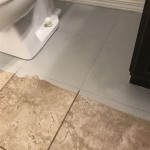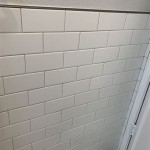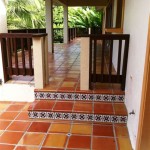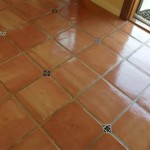Can You Lay Ceramic Tiles On Sand And Cement Floor? A Comprehensive Guide
Laying ceramic tiles is a popular choice for flooring due to their durability, aesthetic appeal, and ease of maintenance. A common question that arises during the planning stages of tiling projects is whether ceramic tiles can be installed directly on a sand and cement floor. The answer is nuanced and depends on several factors, including the condition of the sand and cement base, the intended use of the tiled area, and the specific installation techniques employed. A direct application of ceramic tiles to a poorly prepared sand and cement base can lead to issues such as cracking, unevenness, and tile detachment. Therefore, a thorough understanding of the necessary preparations and considerations is essential for a successful and long-lasting tiling installation.
A sand and cement floor, often referred to as a screed, is a mixture of sand, cement, and water. It is typically used as a sub-floor to provide a level and stable surface for the application of various floor finishes, including ceramic tiles. The screed serves to even out any irregularities in the underlying concrete slab or subfloor, creating a smooth and consistent base. However, the quality and suitability of a sand and cement screed for tiling depend on several factors, including the accuracy of the mixing ratios, the thoroughness of compaction during installation, and the curing process. If the screed is not properly prepared, it may be prone to cracking, crumbling, or excessive moisture retention, all of which can negatively impact the performance of the ceramic tile installation.
The direct application of ceramic tiles onto a sand and cement floor is feasible under specific conditions. However, it is crucial to adhere to strict preparation guidelines and employ appropriate tiling techniques to ensure a successful and durable outcome. Ignoring these guidelines can result in costly repairs and premature failure of the tiled surface. This article will explore the factors that determine the suitability of a sand and cement floor for tiling, the necessary preparation steps, and the recommended installation methods to achieve a professional and long-lasting ceramic tile installation.
Key Point 1: Assessing the Suitability of the Sand and Cement Floor
Before proceeding with any tiling project, a thorough assessment of the existing sand and cement floor is paramount. This assessment involves evaluating several key factors that will determine the suitability of the floor as a substrate for ceramic tiles. A detailed inspection can identify potential problems that need to be addressed before tiling commences. This proactive approach helps to prevent future issues and ensures the longevity of the tiled surface.
Firstly, the structural integrity of the sand and cement floor must be evaluated. This involves checking for cracks, crumbling, or any signs of instability. Cracks can be caused by several factors, including shrinkage during curing, excessive loads, or movement in the underlying structure. A hairline crack may be acceptable if it is stable and does not widen over time. However, significant cracks that are actively widening or showing signs of movement need to be repaired or stabilized before tiling. Crumbling areas indicate that the screed may be weak or improperly mixed, and these areas must be removed and replaced or reinforced. Any instability in the screed will inevitably translate into problems with the tiled surface, leading to cracking or detachment.
Secondly, the levelness of the floor must be checked. Ceramic tiles require a flat and even surface for proper installation. Imperfections in the floor can cause tiles to sit unevenly, creating an unsightly appearance and potential safety hazards. A spirit level or laser level should be used to identify any high or low spots. Minor imperfections can be addressed by using a self-leveling compound or by adding extra adhesive in specific areas. However, significant unevenness may require grinding down high spots or applying an additional layer of screed to level the floor. Accurate leveling is crucial for achieving a professional and aesthetically pleasing tile installation.
Thirdly, the moisture content of the sand and cement floor must be measured. Excessive moisture can interfere with the adhesion of the tile adhesive and lead to mold growth beneath the tiles. A moisture meter should be used to determine the moisture content of the screed. The acceptable moisture level will vary depending on the type of tile adhesive used, but generally, it should be below a certain threshold (typically specified by the adhesive manufacturer). If the moisture content is too high, the floor must be allowed to dry completely before tiling. This may involve using dehumidifiers or fans to accelerate the drying process. Applying a moisture barrier may be necessary in areas prone to dampness.
Finally, the surface cleanliness of the sand and cement floor must be ensured. The floor should be free of dust, dirt, grease, oil, and any other contaminants that could interfere with the adhesion of the tile adhesive. The floor should be thoroughly vacuumed and cleaned with a suitable cleaning agent. Any oil or grease stains should be removed with a degreaser. A clean and properly prepared surface is essential for achieving a strong and durable bond between the tiles and the screed.
Key Point 2: Preparing the Sand and Cement Floor for Tiling
Once the sand and cement floor has been assessed and deemed suitable as a substrate, the next step is to prepare it for tiling. Proper preparation is crucial for ensuring a successful and long-lasting tile installation. This involves addressing any imperfections or weaknesses in the screed and creating a suitable surface for the tile adhesive to bond to.
One of the most important preparation steps is to prime the sand and cement floor. Priming involves applying a thin coat of primer to the surface of the screed. The primer serves several functions. Firstly, it helps to improve the adhesion of the tile adhesive to the screed. Secondly, it seals the surface of the screed, preventing the adhesive from drying out too quickly. Thirdly, it helps to reduce dust and improve the overall bond strength. The type of primer to use will depend on the type of tile adhesive being used and the condition of the screed. A general-purpose acrylic primer is suitable for most applications, but a more specialized primer may be required for porous or dusty screeds. The primer should be applied according to the manufacturer's instructions, typically with a brush or roller.
Another important preparation step is to fill any cracks or imperfections in the sand and cement floor. Small cracks can be filled with a flexible crack-filling compound. Larger cracks may require more extensive repairs, such as removing and replacing the damaged section of screed. Imperfections in the surface of the screed can be filled with a self-leveling compound. This will create a smooth and even surface for the tiles to be installed on. The self-leveling compound should be applied according to the manufacturer's instructions, typically by pouring it onto the floor and spreading it with a trowel.
In some cases, it may be necessary to apply a decoupling membrane to the sand and cement floor before tiling. A decoupling membrane is a thin, flexible layer that is installed between the screed and the tiles. The membrane serves to isolate the tiles from any movement or stresses in the screed. This can help to prevent cracking and detachment of the tiles, particularly in areas that are subject to heavy traffic or temperature fluctuations. Decoupling membranes are particularly useful when tiling over screeds that are prone to cracking or movement. They are available in a variety of materials, including polyethylene and polypropylene. The membrane should be installed according to the manufacturer's instructions, typically by adhering it to the screed with a suitable adhesive.
Finally, it is important to ensure that the sand and cement floor is thoroughly clean before tiling. Any dust, dirt, or debris can interfere with the adhesion of the tile adhesive. The floor should be vacuumed and wiped down with a damp cloth. Any oil or grease stains should be removed with a degreaser. A clean and properly prepared surface is essential for achieving a strong and durable bond between the tiles and the screed.
Key Point 3: Selecting and Applying the Appropriate Tile Adhesive
The choice of tile adhesive is critical for a successful ceramic tile installation on a sand and cement floor. The adhesive must be compatible with both the tiles and the screed and provide sufficient bond strength to withstand the expected loads and environmental conditions. Selecting the wrong adhesive can lead to tile detachment, cracking, and other problems.
Several types of tile adhesive are available, each with its own properties and suitability for different applications. Cement-based adhesives are the most common type and are suitable for most ceramic tile installations. These adhesives are typically composed of cement, sand, and polymers, and they are mixed with water to form a paste. Cement-based adhesives are available in a variety of grades, depending on their bond strength and flexibility. A flexible cement-based adhesive is recommended for tiling over sand and cement floors, as it can accommodate slight movement or stresses in the screed. Epoxy-based adhesives are another option, but they are typically more expensive and require specialized application techniques. Epoxy adhesives are highly resistant to water and chemicals, making them suitable for demanding environments such as bathrooms and kitchens.
Regardless of the type of adhesive chosen, it is important to select a product that is specifically designed for use with ceramic tiles and sand and cement floors. The adhesive manufacturer's instructions should be carefully followed regarding mixing ratios, application techniques, and curing times. Using the correct amount of water when mixing the adhesive is essential for achieving the proper consistency and bond strength. Over-watering the adhesive can weaken it, while under-watering it can make it difficult to spread. The adhesive should be mixed thoroughly until it is smooth and free of lumps.
The adhesive should be applied to the sand and cement floor using a notched trowel. The size and shape of the notches on the trowel will determine the thickness of the adhesive layer. The correct trowel size will depend on the size and type of tiles being used. Larger tiles typically require a thicker adhesive layer. The adhesive should be applied in a consistent pattern, ensuring that the entire surface is covered. Avoid applying too much adhesive, as this can make it difficult to set the tiles properly. The tiles should be pressed firmly into the adhesive, using a twisting motion to ensure good contact. Excess adhesive should be wiped away immediately. Spacers should be used to ensure consistent joint widths between the tiles. The joints should be filled with grout after the adhesive has cured, typically after 24 to 48 hours.
The curing time of the tile adhesive is crucial for achieving a strong and durable bond. The adhesive should be allowed to cure completely before the tiled surface is subjected to heavy traffic or moisture. The curing time will vary depending on the type of adhesive and the environmental conditions. The adhesive manufacturer's instructions should be consulted for specific curing time recommendations. During the curing process, the tiled surface should be protected from direct sunlight, rain, and extreme temperatures. Following these guidelines will help to ensure a successful and long-lasting ceramic tile installation on a sand and cement floor.

How To Install Ceramic Tiles On Concrete Floor Tile Installation
:max_bytes(150000):strip_icc()/can-you-install-tile-directly-on-concrete-1822600-04-458f7bb6c78348c1835cf8054ef36553.jpg?strip=all)
How To Install Tile Over Concrete
How To Tile Onto Concrete Floors Porcelain Super

How To Install Ceramic Tiles On Concrete Floor Tile Installation
When Cementing Tile Why Do People Add Rows To The Cement Instead Of Just Leaving It Smooth Quora
How To Lay Floor Tiles On Concrete Stonesuper

Materials Needed To Lay Tile Floor The Best Tools Rubi Blog Usa

How To Install Ceramic Tiles On Concrete Floor Tile Installation

How To Install Ceramic Tiles On Concrete Floor Tile Installation

Cement Sand Ratio For Tiles Flooring What Is Of Used To Fix On Floor
Related Posts








